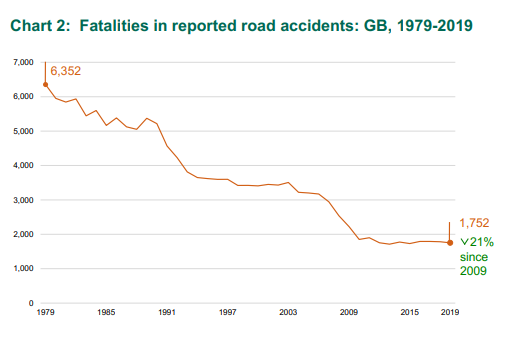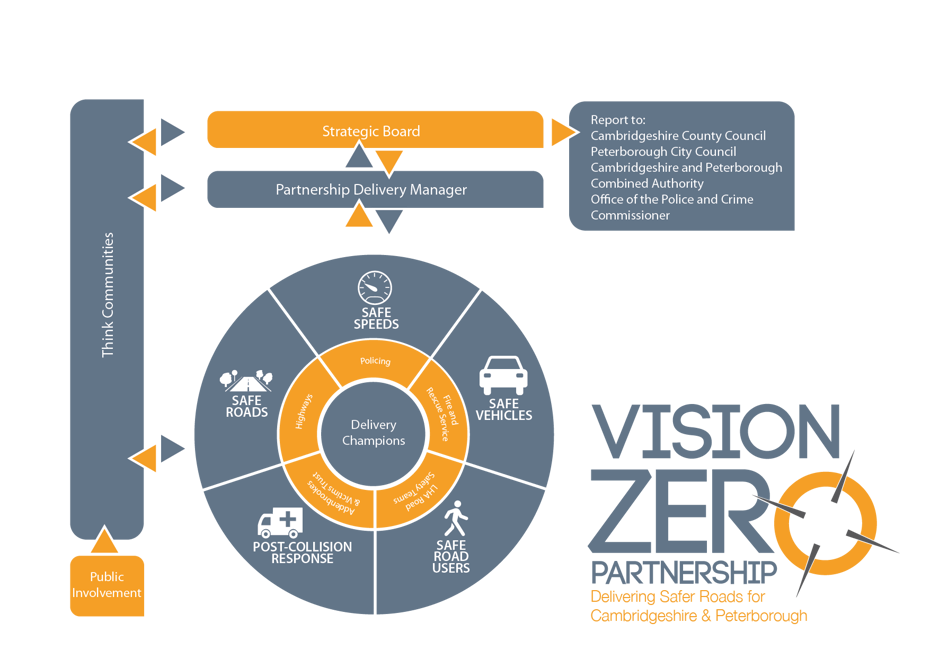By Tanya Fosdick, Agilysis
Road safety in Great Britain greatly improved in the 30 years from 1979 to 2009, with changes in legislation (seatbelt wearing and the introduction of evidential breath testing); improvements in vehicle design; and the introduction of safety cameras all contributing to reductions in the numbers of fatalities. But since 2010, there has been little change in the numbers of those killed on the country’s roads, suggesting change is required. When Iain Temperton from Traject (visit the Traject website) and us at Agilysis (visit the Agilysis website) were commissioned by Cambridgeshire’s Police and Crime Commissioner to help the road safety partnership with its future strategy, we saw this as a really positive opportunity to make a difference.

Why might casualty reduction have slowed?
No-one is quite sure why the numbers of fatalities have remained around the same for the last 10 years, and Great Britain is not alone in this.
The ‘big wins’ may have been made with improvements in in-vehicle safety making a large difference to survivability but also making further reductions harder to achieve.
The UK hasn’t had road safety targets in this period, and targets have been shown elsewhere to be useful tools for focusing efforts and resources, providing accountability for actions.
There have been reductions in roads policing in recent years and also many cluster sites have received engineering treatments, with collisions spread out across the network, making it difficult to identify locations for future work.
Localism has been the prevailing philosophy, which has meant a lack of national road safety leadership and no consistency of approach, although it does provide places like Cambridgeshire and Peterborough with an opportunity to adopt their own approach.
Out with the old and in with the new
Before recommending how the road safety partnership in Cambridgeshire and Peterborough could move forward, we needed to understand its current strengths and weaknesses. As independent outsiders, we could take an impartial view of governance, structure and strategy, encouraging honest feedback from partner organisations through interviews. We also went out to members of the public, asking the residents and road users of the county who they think should be involved in road safety and where the priorities should lie. Detailed casualty analysis was undertaken to understand what the issues are and who the target groups might be. All of this information was brought together in a ‘needs analysis’, allowing us to see what should be improved and where the partnership was performing well.
There were a lot of strengths…. The existing partnership made good use of data and evidence, with partners passionate and committed to reducing casualties. There was a well-established partnership, including representatives from Public Health and the Police and Crime Commissioner (organisations not seen at the table of every road safety partnership). There was a desire to have a clear strategy and robust structure, inviting new members to avoid silo working. These were all positive traits that we could harness and take forward.
There were some frustrations, however… Most of these frustrations related to structure and governance: it was felt that the partnership lacked direction, was unfocused and didn’t speak with a unified voice. There was no ownership, too many layers of bureaucracy and a reliance on individuals. Whilst the responsibilities and activities of different organisations brings strengths, it also meant there were different priorities and different cultures. But none of these frustrations were insurmountable, especially through the adoption of the Safe System.
What is the ‘Safe System’?
It became clear to us that the adoption of the Safe System would work well in Cambridgeshire. This approach would provide the direction the partnership lacked and bring together the different partners, allowing them to play to their strengths.
The Safe System is a concept in road safety which originated in Sweden and the Netherlands in the 1980s and 1990s and starts with the concept that no human being should be killed or seriously injured as the result of a road crash.
There are four principles which are central to a Safe System:
- First, people make mistakes that can lead to road collisions.
- Second, the human body has a known, limited physical ability to tolerate collision forces before harm occurs.
- Third, while individuals have a responsibility to act with care and within traffic laws, a shared responsibility exists with those who design, build, manage and use roads and vehicles to prevent collisions resulting in serious injury or death and to provide post-collision care.
- Fourth, all parts of the system must be strengthened in combination to multiply their effects, and road users are still protected if one part fails.[1]
It requires a new approach to road safety, which is more proactive. It stresses that there is a shared responsibility for road safety, moving away from a focus on making road users compliant. It continues to be important that road users comply with the rules of the system, but also that the system is forgiving when people make mistakes. Information giving and enforcement are still important, but they need to be coordinated with safe vehicle and road design, speed choice, and post collision response.
There are five components for action:
- Safe People
- Safe Vehicles
- Safe Speeds
- Safe Roads and Roadsides
- Post collision response
A system where there are safe roads, safe vehicles, safe speeds, safe people and high-quality post-crash response will reduce the likelihood of a death or serious injury occurring in the event of a collision.

What does this mean for Cambridgeshire and Peterborough?
To help the partnership adopt a Safe System approach, we put in place a number of changes:
- A new structure
- A new target
- A new name
- A new relationship with road users
- A new way of working
- A new strategy
A New Structure
To give the partnership the accountability and direction it required, it needed a strong structure. Governance comes from the two local authorities and the Cambridgeshire and Peterborough Combined Authority. The Strategic Board, as budget holder, oversees the work of the partnership, approving spend and the ‘Plans on a Page’ for the forthcoming year. The Board will ensure that the direction of the Vision Zero Partnership is evidence-led and focused.
A new role was created: ‘Partnership Delivery Manager’. The Partnership Delivery Manager oversees the work of the Safe Systems Working Groups and supports delivery, ensuring co-ordination between activities. The role includes challenging the Working Groups to ensure that evidence and data are at the core of intervention and activity design.
Day-to-day activities and partnership projects are delivered by Safe System Working Groups, a new approach based on international best practice, where each Working Group focuses on a specific element of the Safe System, working in collaboration with the rest of the system.
A New Target
The vision of the partnership is to move towards zero deaths or severe serious injuries in the Partnership area by 2040. This is an ambitious goal and will require hard work to achieve.
To track progress towards this vision, a 2030 target has also been set, based on international declarations in road safety. The partnership is aiming to achieve a 50% reduction in road deaths and serious injuries by 2030.
A New Name
To mobilise partners and to publicly state the intention of the partnership, the name has changed to the Vision Zero Partnership (delivering safer roads for Cambridgeshire and Peterborough).
A New Relationship with Road Users
The Safe System suggests a joint responsibility for road safety, a responsibility shared with road users. Think Communities is a collaboration between Cambridge City Council, Cambridgeshire Council, Peterborough City Council, Cambridgeshire Constabulary and the district councils of East Cambridgeshire, Fenland, Huntingdonshire and South Cambridgeshire. It empowers and enables communities, providing an opportunity to work together to create healthy, safe communities. Find out more about Think Communities on the Cambridgeshire County Council website.
This element is particularly exciting for us; directly involving the community within the road safety partnership is unusual BUT with the adoption of a Safe System approach, it is essential. All eyes are on the Vision Zero Partnership to see how these community relationships evolve.
A New Way of Working
The new structure, target and new community engagement all lead to a new way of working. There are some fundamental elements to the new approach, including:
- Creating ‘Plans on a Page’, where each Working Group sets out their planned activities for the coming year, detailing the evidence base and evaluation plans to show effectiveness.
- The use of data and good quality information to ensure interventions are evidence-led.
- Monitoring progress through the use of ‘Safety Performance Indicators’, which provide quantitative data to track how safe the system is becoming.
- The use of behaviour change models in intervention design.
- Regular public surveys to measure local attitudes, knowledge and self-reported behaviour.
- Embedding evaluation and methods for measuring effectiveness into delivery plans.
- The use of workstream approval forms to justify activities and seek funding from the Strategic Board.
A New Strategy
All of these new working practices and changes in approach are detailed in the new Strategy, provided on this website. It acts as a guide for the Vision Zero Partnership to follow and an explanation to the public as to how the partnership will operate from now on.
Wishing them on their way
Iain and I really enjoyed working on this project and are excited to see progress as the Vision Zero Partnership takes the new strategy forward. Until recently, the Safe System has been a philosophy adopted at a national or supranational level, but this doesn’t mean it is not relevant at a local level.
The passion we encountered amongst the partners can be harnessed by the Safe System, strengthening the way the partnership works and providing an opportunity to follow international best practice for the benefit of road users and residents in Cambridgeshire and Peterborough. We will follow your progress with interest.
References:
[1] RoadSafe. (2020). The Safe System. Retrieved March 9, 2020, from RoadSafe: http://www.roadsafe.com/safesystem

